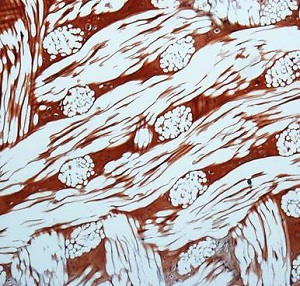 |
| Cartilage (red) fills in around a polymer scaffold embedded with growth factor-producing stem cells.--Courtesy of Duke |
To regenerate tissue such as cartilage in the body using stem cells, researchers at Duke University have created a system using a scaffold to deliver gene therapy with built-in growth factors that allow for a programmed regenerative response.
The team at Duke created a biodegradable synthetic scaffold that is structurally similar to cartilage. The scientists want natural cartilage to form around the polymer scaffold while it's there, and for this they have used growth factor proteins to make that cartilage out of stem cells.
But delivering the growth factors can be a problem. Once the scaffold and stem cells are implanted, it can be difficult to replenish these necessary growth factors after their initial release. To overcome this obstacle, the team looked for a long-term delivery method for the growth factor.
By altering the stem cells in a way that allows them to create their own growth factors, the scaffold wouldn't need the same intermittent delivery.
"One of the advantages of our method is getting rid of the growth factor delivery, which is expensive and unstable, and replacing it with scaffolding functionalized with the viral gene carrier," Duke biomedical engineer and study author Charles Gersbach said in a statement. "The virus-laden scaffolding could be mass-produced and just sitting in a clinic ready to go. We hope this gets us one step closer to a translatable product."
Beyond cartilage, the team is looking into using the scaffold on other tissues in the orthopedic realm such as tendons, ligaments and bones, according to the university. The study appeared in the Proceedings of the National Academy of Sciences.
"We want the new cartilage to form in and around the synthetic scaffold at a rate that can match or exceed the scaffold's degradation," said team member Jonathan Brunger in a statement. "So while the stem cells are making new tissue (in the body), the scaffold can withstand the load of the joint. In the ideal case, one would eventually end up with a viable cartilage tissue substitute replacing the synthetic material."
- here's the Duke announcement
- get the research abstract